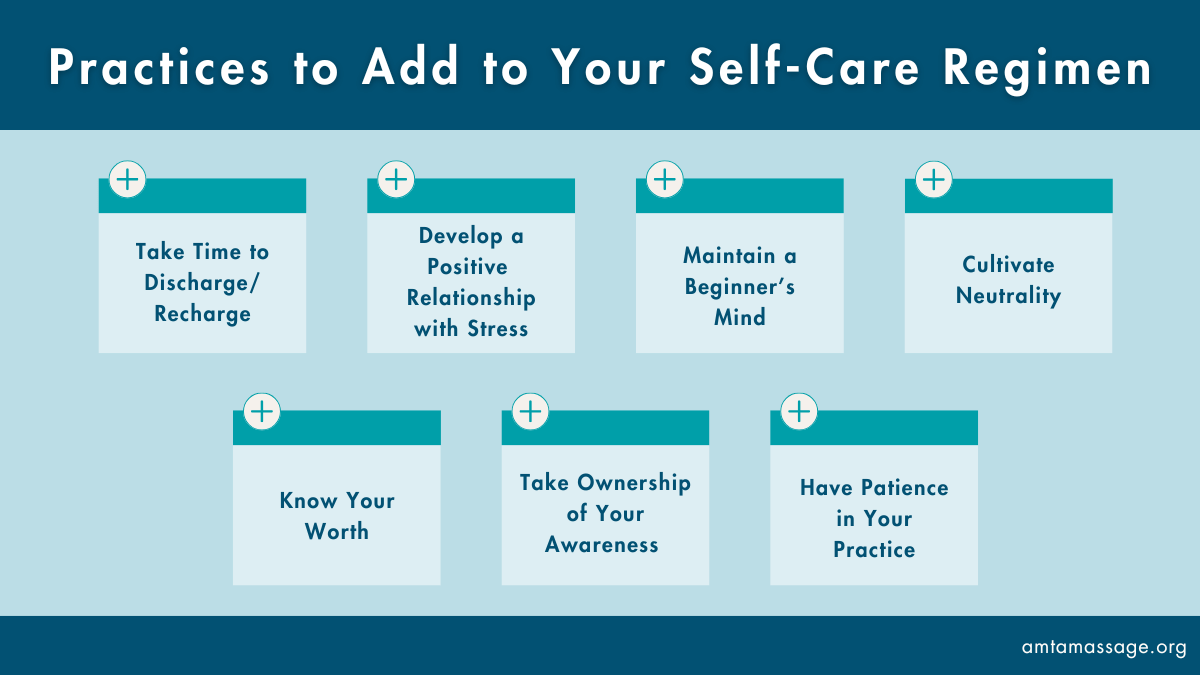Self-Care: Understanding What’s at Stake
Massage therapy is a demanding profession, both physically and mentally, as we know from the number of massage therapists who are forced to leave the profession—either temporarily or permanently—because of injury or burnout.
I myself have felt like I was close to the end of my own run on occasion.
I continually draw inspiration, however, from the stories of practitioners with 20, 30, 40 years or more in the industry and practices that are as vibrant as I felt on my first day of class. When you spend time with such people, you realize that it’s not just their physical endurance that sustains them, nor some magical energy.
Their bodies age and ache just as much as anyone else’s. In most cases, the difference is their holistic approach to self-care, which includes not just managing physical health, but also managing energy, taking ownership of stress, continually finding inspiration, seeing the bigger picture, having the right motivation, weathering the storms of loss and facing the fears of change.

All of these qualities are hard to teach as part of a curriculum because they are unique to every person. What is common is that they are all part of being a human being—and we can’t separate our being human from our work. The more we can synthesize our work with our humanity, the better able we’ll be to transform the way we work into a way of caring for ourselves.
We’ll dive into this by looking at a few practices that may be easily woven into your current self-care regimen, including: taking time to discharge, developing a positive relationship with stress, maintaining a beginner’s mind, cultivating neutrality, knowing your worth, taking ownership of your awareness and having patience in your practice.
Understanding How Discharge/Recharge Can Help You Maintain Your Energy
“The whole world can be explained in just one sentence. ‘What is being discharged is old and what is being charged is new.’” — Dada Bhagwan
We are in a state of continual charge, and much like batteries we need to recharge ourselves. If we go too long without a power source, we run out of juice. What’s more is that our charges are shifting positively and/or negatively per our interactions with sources of energy that possess their own charges, including other people.
When energies mix and mingle in as intimate a setting as a massage, it’s prudent to pay attention to how your own energy feels afterward.
You may feel the need to recharge from the expense of energy or you may even feel the need to discharge an accumulation of extra energy. Either way, there is an energetic imbalance that you would do well to correct before your next session or before you go home.
You may not have any real opportunities to fully rebalance your energy until the end of your day. There are quick ways to restabilize yourself between sessions, however:
- Taking a minute of mindful breaths
- Step outside and stand in the grass, if it’s warm enough, or just stay quiet for a minute and listen to what’s going on in nature
- Brew a quick cup of herbal tea and take time to enjoy, noticing the flavors and warmth on your tongue
These little respites can help you maintain your energy throughout your workday. Still, you should plan for a full discharge session at the end of your day that is ideally long enough to create a sufficient buffer between the workspace and your home whenever possible.
This self-care may look like stopping by the gym to exercise on your way home, taking some time to lay down before moving onto the next thing, or even talking with colleagues.
Work has a way of coming home with us and even more so nowadays with text, emails and social media. Resist the urge to dive right back into work mode at home through such mediums and do your best to give those things their own space to be addressed.
Stress Is Not the Enemy: Using Challenges to Your Advantage
“Adopting the right attitude can convert a negative stress into a positive one.” — Hans Selye
In the 1990s, researchers explored how to create contained ecosystems and assess their viability for purposes such as building colonies on other planets.
Within these biospheres, they noticed something interesting about tree growth: trees grew much faster than they would in normal conditions but started to fall over after reaching a certain size.
What they found was that the trees’ weakness was largely caused by a lack of stress wood, which in natural conditions is developed in response to wind.
One of the oldest trees in the world, a 5,000 year old bristlecone pine named Methuselah, is just an eight-hour drive east from San Francisco. I think of this idea of strength born from challenge when I see the contortions of the trunk, the adjustments this tree has been forced to make while enduring varying wind speeds over the millenia.
Then I ask myself: Have the unique stressors I’ve encountered in my life made me stronger and more aware? In many ways, the answer is “yes.”
When you’re feeling stressed or overwhelmed, consider the following:
- When you think about the challenges you’ve faced, both personally and professionally, what stands out to you most?
- Have you, like Methuselah, been able to adjust?
- What have the challenges you’ve faced taught you about your own resilience
- How can those lessons be used to endure—perhaps even welcome!—future challenges?
Be conscious of how you’re thinking about stress and try to remember the notion of healthy stress or “eustress,” where stressors are viewed as positive opportunities for growth rather than adversities to be avoided.
When we take an active role in stress, we take responsibility for it. When we take ownership of our stress, we also take control of its effect on us. Consequently, we can both protect and enrich ourselves at the same time.
The Beginner’s Mindset: How to Stay Inspired
“In the beginner's mind there are many possibilities, but in the expert's mind there are few.” — Shunryu Suzuki
Burnout is common in most professions, but may be particularly prevalent in hands-on practices like massage therapy, where the work is often physically and emotionally demanding.
Think back to when you first went to massage school and recall the excitement of learning so many new skills, techniques and modalities. Remember how excited you were to begin your career and start working with clients?
When I graduated from massage school, I felt like a whole new world opened up for me—and I was ready to explore. After some years in practice, however, that world began to feel smaller, and I found that the energy I once focused on developing and pursuing my passion for massage was now reserved for just getting through my workday.
Soon, I went back to school, thinking that pursuing a graduate degree was the key to reigniting my passion. I started applying to schools, believing the academic route would open up more fields for exploration.
What I found, however, was that all I really wanted to learn is how to better help my massage clients. I didn’t want to stop doing massage; I wanted to deepen my knowledge and understanding of the work I love.
The real lesson?
I realized I learned more about the body attending weeklong workshops in massage than I did in any biology course in college. What was even better was that I could apply just about everything I learned through the experiential nature of massage continuing education immediately to my work.
Part of self-care is finding ways to stay inspired and connected to your work to help you keep your passion for massage alive. If you feel like you’re getting stuck, you might try some of the following ideas:
- Connect with experienced massage practitioners. What I consistently noticed was experienced practitioners are willing to attend more training and are open to learning, not just from their peers with as many years in the profession as they have, but also from their students.
- Stay curious. Stay in that same frame of mind that you had when you first started school, and be open to the possibilities of utilizing different principles and methods. Read an article on a technique you’ve been wondering about, or register for that class you’ve been considering. Even just chatting with a colleague about how they approach a particular issue can open up possibilities you hadn’t thought of before and rekindle the excitement.
The lesson learned from this is timeless yet simple: Stay in the beginner’s mindset and you’ll protect yourself against getting bogged down in a rut.
Slowing Down Is Self-Care
“Don’t just do something, stand there.” — The White Rabbit, Alice in Wonderland
There have been numerous times I’ve felt overwhelmed trying to meet the needs of a client. There are days when nothing I do seems to work and the muscle doesn’t get any less tense. The harder I work, the worse things feel in my own body.
In my first years as a massage therapist, I could power through those periods of stagnation and still feel satisfied in knowing that I tried my best. Unfortunately, I learned fast that “powering through” is not a sustainable way of practicing and quickly led to my injuring myself in various ways.
Then, I began watching practitioners who have been in the massage profession for several years, and I noticed something very different about their approach.
After performing a technique on a client they would just stop, sit down and take a breath. Without cue, the client would stop and take a breath as well. The session would then continue with another intervention followed by another moment of pause.
Seeing this give-and-take had a profound impact on me because I previously felt the need to keep moving for the entire hour in session. I equated the value of the session with how much time my hands were on the client. In this alternative way of working, the value became the level of presence I maintained with the client and how well I could hold a healing space.
I began to connect with my work on an entirely different level that leaves me feeling more fulfilled than drained. I left sessions feeling as though I’d just spent an hour in meditation rather than in a workout.

